Recreational Vans

Relay boards for lighting turn small control signals into reliable power switching for larger loads. A relay uses a coil to pull contacts together, letting a low current switch or controller command a high current light without carrying the heavy load through the cabin switch. This separation improves safety and reduces voltage drop to the lights.
Typical boards group multiple relays and fuses on one plate or enclosure. Each channel has a dedicated fuse sized to the wire and light load, a relay to handle switching, and screw or sealed connectors for clean service. The board becomes a lighting hub, making it easy to add roof lights, fogs, ditch lights, rear work lights, or scene lighting.
When the coil energizes, the magnetic field collapses on release and can create a voltage spike. A flyback diode or transient suppressor across the coil tames that spike, protecting switches, microcontrollers, and vehicle networks. Good boards integrate suppression so you do not have to add parts at every switch leg.
LED lights draw less steady current than halogen, yet many drivers have high inrush at turn on. That brief surge can be several times the running current. Choose relay contacts and fuses that can survive both the surge and the continuous load.
Start with the light’s running current and expected inrush. A 180 watt light bar at 12 volts draws about 15 amps running, but inrush can spike two to three times higher. Use relays with a contact rating above the surge and a continuous rating with margin. Many automotive relays are rated 30 to 40 amps at 14 volts DC, which suits most auxiliary lights when wired correctly.
Match the coil voltage to the control source. Vehicles are typically 12 to 14 volts, while some marine or RV platforms may be 24 volts. Mixed voltages on one board complicate triggers and diagnostics, so keep coil voltage consistent per board.
Wire size affects voltage drop and heat. Keep runs short and use adequately sized conductors:
Fuse each output as close to the feed as possible. The fuse protects the wire, not the device. If you daisy chain multiple outputs from one feed, add a main fuse or breaker on the feed and individual fuses per channel. Many builds use a main MIDI or MAXI fuse near the battery and ATO or ATC fuses on each circuit.
Grounds matter as much as power. Run returns to a known clean chassis point or, better, a ground bus tied to the negative battery post. Poor grounds cause dim lights, relay chatter, and intermittent faults that are tough to trace.
Decide how you want to command each light. Simple rocker switches work well when wired to the relay coils. Momentary switches can trigger latching logic if you want press on and press off behavior. If you need scenes, time delays, or automatic shutoff, a small controller can drive coils while the relays do the heavy lifting.
High side switching puts the relay on the positive leg to the light, which is standard in most vehicles. Low side switching uses the relay to connect the light to ground. High side is easier to diagnose and generally safer for add ons.
Relays are great for on and off control. They are not for dimming. If you want dimmable scene lighting, use a dedicated LED driver or a MOSFET dimmer module for that channel, and keep the relay as the master on and off gate upstream.
Mount the board where heat, water, and mud cannot reach it easily. Engine bays get hot, so choose components with the right temperature ratings and consider a sealed enclosure. In cargo areas, mount the panel where you can reach fuses and labels quickly. Use sealed connectors such as Deutsch style for reliability, and add service loops so components can be replaced without rewiring the whole system.
Label everything. Mark each fuse value, relay function, and control input. Future you will thank present you when a night trail run turns into a five minute fuse swap instead of a roadside puzzle.
Solid state power distribution modules use transistors instead of mechanical contacts. They offer quiet operation, fast fault response, and software control. For very high inrush or inductive loads, mechanical relays still shine. In many rigs, a mix works best: solid state for lower current or programmable circuits, relays for high current auxiliary lighting.
OZK Customs can integrate relay boards and related power distribution cleanly into a full vehicle build, ensuring switches, controllers, and lights cooperate without drama. If you want a lighting system that feels factory but works far beyond stock, build it into the overall electrical plan rather than as a last minute add on.
Ready to take the next step? Explore how our team outfits adventure rigs and van platforms with organized lighting control that is easy to use and service. See what is possible with recreational vans, review our approach to custom van builds, or browse our mainstream vans to start with a finance friendly platform.
Lighting should enhance your trip, not create electrical gremlins. OZK Customs designs and installs relay boards for lighting that are fused correctly, labeled clearly, and built for the environments you drive. Tell us how you travel, what you carry, and how you camp. We will engineer the switching, protection, and wiring that keeps your lights bright and your nights simple.
Ready to simplify lighting control and avoid wiring headaches? OZK Customs designs and installs clean relay panels with proper fusing, sealed connectors, and serviceable layouts. Tell us how you use your rig, and we will engineer a lighting system that just works. Start your build plan today.
ADDRESS:
6159 E Huntsville Rd, Fayetteville, AR 72701
PHONE:
(479) 326-9200
EMAIL:
info@ozkvans.com